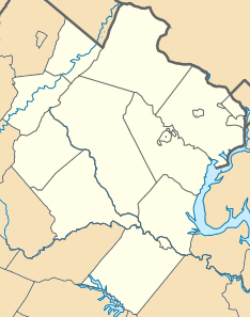Matthew Fontaine Maury School
|
Matthew Fontaine Maury School | |
|
Matthew Fontaine Maury School, Fredericksburg, Virginia | |
   | |
| Location | 900 Barton Street, Fredericksburg, Virginia |
|---|---|
| Coordinates | 38°18′02″N 77°27′53″W / 38.3006°N 77.4648°WCoordinates: 38°18′02″N 77°27′53″W / 38.3006°N 77.4648°W |
| Area | 7.4 acres (3.0 ha) |
| Built | 1920 |
| Architect | Stern, Philip Nathaniel |
| Architectural style | Colonial Revival |
| NRHP Reference # | 07000133[1] |
| VLR # | 111-0009-0014 |
| Significant dates | |
| Added to NRHP | March 7, 2007 |
| Designated VLR | September 6, 2006[2] |
The Matthew Fontaine Maury School (also known as Maury School) (pictured), in Fredericksburg, Virginia, is an historic school building noted for its Colonial Revival architecture and design as well as its significance in the entertainment and cultural life of Fredericksburg. The architect of the building was Philip Stern. Built in 1919-1920, the school was used from then until 1952 for both elementary and high-school students. After the construction of James Monroe High School, the building was used as an elementary- and middle-school. The school was closed in 1980. Maury School was added to the National Register of Historic Places in March 2007.[1][3]
History
The school is located on in an area of Fredericksburg bounded by George, Kenmore, William and Barton streets. The site had been previously used as a potter’s field and an African-American cemetery. Prior to construction, the graves were relocated to Shiloh Cemetery in Fredericksburg. The original school building was Fredericksburg High School. It consisted of one building facing George Street. An auditorium was added to the school in 1930.[4]
In 1937, the school was enlarged with the addition of James Monroe Elementary School, a separate building connected by a covered walk, and the name was changed to James Monroe High School. In 1952, when the city built a new high school, the building was renamed Matthew Fontaine Maury School and served as the city's middle school until it was closed in 1980.[4] After the school was closed, it was used for several years by the Fredericksburg Police Academy and, later, as a homeless shelter. In 2007, the Maury School building was converted into condominia.[5]
Maury stadium
Included in the Historic Places designation is the school's stadium. This stadium was built in 1935 and, despite the construction of two different high schools to replace it, James Monroe High School sports teams continue to use it for home games. On the slope between the school and the field, bleachers of stepped-concrete bleachers were built. A brick balustrade forms the edge of the spectators' area.[4]
The stadium has been called "the City Stadium". It is the largest public gathering place in Fredericksburg. It is the venue for concerts and other community events. The stadium was also home to the Fredericksburg Dog Mart. The Dog Mart began with a 1698 agreement between the village that was to become Fredericksburg and the Manahoac Indian tribe. Held each year, this event brought as many as 15,000 people to the school.[4][6]
Matthew Fontaine Maury
The school is named for Matthew Fontaine Maury (1806–1873), a Spotsylvania County, Virginia native who was known as the "Pathfinder of the Seas". Maury studied ocean currents and published the first reliable oceanographic charts. Maury was involved in the founding of the United States Naval Academy at Annapolis, Maryland and taught at the Virginia Military Institute.[7][8]
Design and construction
Maury School reflects a Colonial Revival-style architecture.[1] The school is made up of three matching buildings with 65,000 square feet of space. The first building opened in 1920 and was called Fredericksburg High School. The school was designed to serve white students in grades 7 - 12. In 1930 an auditorium and gym were added. An identical building was built in 1937 to house elementary school students and is connected by a covered walkway. The architect of the buildings was Philip Nathaniel Stern (1878–1960) of Fredericksburg, who was also architect for many of the buildings at what is now the University of Mary Washington. Historian and writer Jack D. Warren, Jr. called Maury School “the best example of institutional Colonial Revival architecture in Fredericksburg".[4]
References
- 1 2 3 National Park Service (2010-07-09). "National Register Information System". National Register of Historic Places. National Park Service.
- ↑ "Virginia Landmarks Register". Virginia Department of Historic Resources. Retrieved 19 March 2013.
- ↑ "What should we do with Maury School?". The Free Lance-Star; Fredericksburg, Virginia. 25 November 2005. Retrieved 6 June 2012.
- 1 2 3 4 5 "Matthew Fontaine Muary School" (PDF). National Register of Historic Places Registration Form. United States Department of the Interior; National Park Service. Retrieved 9 June 2012.
- ↑ Battle, Emily (2 January 2007). "Maury School's midterm look Work continues on conversion". The Free Lance-Star; Fredericksburg, Virginia. Retrieved 6 June 2012.
- ↑ Virginia Commission of Game and Inland Fisheries (1962). "Virginia Commission of Game and Inland Fisheries". Virginia wildlife. 23 (6). Retrieved 9 June 2012.
- ↑ Amrhine, Richard (11 May 2007). "Maury School back in session with 32 condos". The Free Lance-Star; Fredericksburg, Virginia. Retrieved 6 June 2012.
- ↑ Clancy, Paul (2010-10-03). "Interesting secret found inside Maury portrait". The Virginian-Pilot (Norfolk, VA). via HighBeam Research. Retrieved 2012-06-08. (subscription required)

